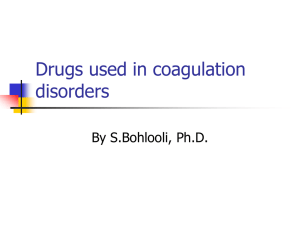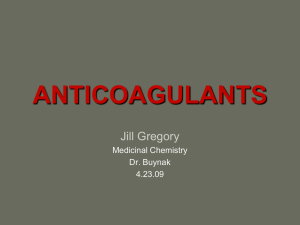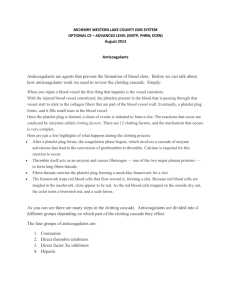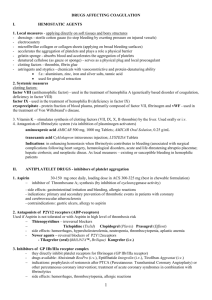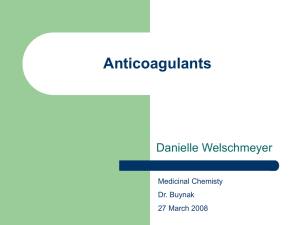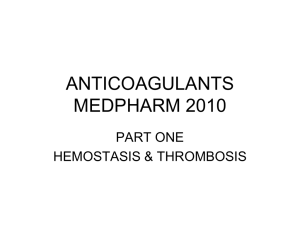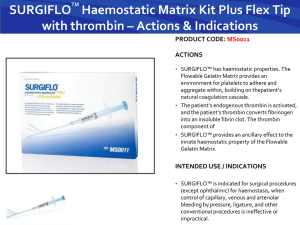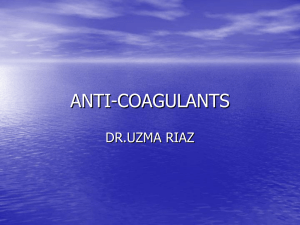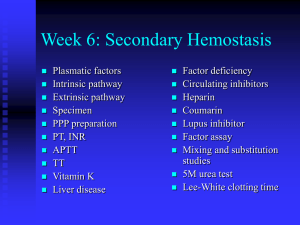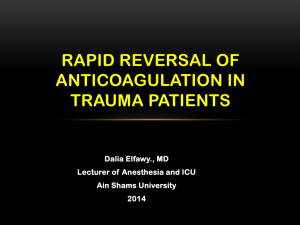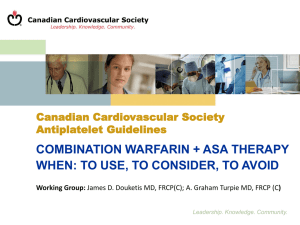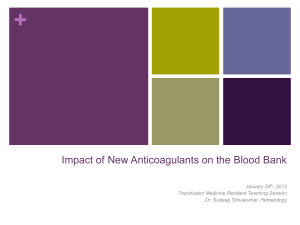Drugs influencing coagulation
advertisement
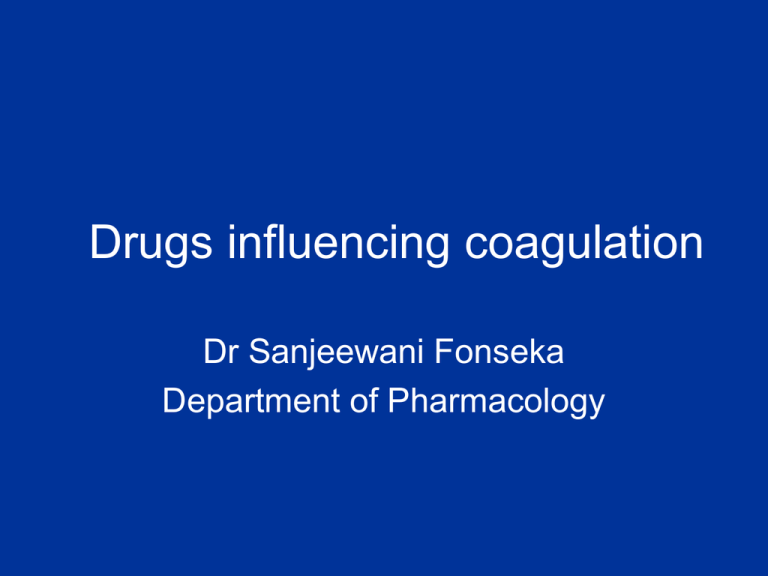
Drugs influencing coagulation Dr Sanjeewani Fonseka Department of Pharmacology Classes of Drugs • Prevent coagulation • Dissolve clots • Prevent bleeding and hemorrhage Hemostatic • Overcome clotting deficiencies (replacement therapies) Classes of Drugs • Prevent coagulation • Dissolve clots • Prevent bleeding and hemorrhage Hemostatic • Overcome clotting deficiencies (replacement therapies) Haemostasis Arrest of blood loss from damaged blood vessels Blood Clotting • Vascular Phase • Platelet Phase • Coagulation Phase • Fibrinolytic Phase Vascular Phase Vasoconstriction Exposure to tissues activate Tissue factor and initiate coagulation Tissue Factor Coagulation Phase Two major pathways Intrinsic pathway Extrinsic pathway Both converge at a common point 13 soluble factors are involved in clotting Normally inactive and sequentially activated Intrinsic Pathway Extrinsic Pathway Tissue Injury Blood Vessel Injury XIIa XII Tissue Factor XIa XI IXa IX VIIa Xa X Prothrombin Fibrinogen VII X Thrombin Fribrin monomer Intrinsic Pathway Activated partial thromboplastin test (aPTT) Extrinsic Pathway Prothrombin test (PT/INR) Vitamin K-Dependent Clotting Factors Vitamin K VII IX X II Synthesis of Functional Coagulation Factors Natural anti- coagulant Thrombosis Pathological formation of haemostatic plug within the vasculature in the absence of bleeding Arterial • White • Platelet and WBC • With atheroscerosis • Causes ischemia Venous • Red • White head and red tail • Embolus Drugs effect ; • fibrin formation Drugs influencing coagulation Anticoagulants • Platelet function • Antiplatelet drugs • Fibrinolysis • Thrombolytic drugs Drugs influencing coagulation • Anticoagulants • Antiplatelet drugs • Thrombolytic drugs Anticoagulants • Antithrombin activators • Direct thrombin inhibitors • Direct Factor Xa inhibitors • Drugs that oppose action of Vitamin K Anticoagulants • Antithrombin activators – Heparin / LMWH – Synthetic pentasaccharide analogues • Direct thrombin inhibitors • Direct Factor Xa inhibitors • Drugs that oppose action of Vitamin K Heparin • Heterogeneous mixture of branched glycosaminoglycans • Potentiates the inhibition of IIa, IXa, Xa, XIa, XIIa by AT • Binds to AT through a unique pentasaccharide sequence leading to a conformational change Intrinsic Pathway Extrinsic Pathway Tissue Injury Blood Vessel Injury Tissue Factor XIIa XII Thromboplastin XIa XI IXa IX Xa X Factors affected By Heparin VIIa Prothrombin Fibrinogen VII X Thrombin Fribrin monomer Heparin mechanism of action Heparin Antithrombin III Thrombin Heparin • Given s.c. or i.v. • Binds to plasma proteins, endothelial cells & macrophages • Elimination – Depolymerisation in endothelial cells & macrophages (rapid, saturable) – Renal (slow, non-saturable) and RES Heparin: variable anticoagulant effect • Variable protein binding • Clearance varies with chain length • Therefore, anticoagulant response monitored by activated partial thromboplastin time (APTT) • Target 1.5 – 2.5 times control Heparin: clinical uses • Venous thrombosis ± embolism • Acute coronary syndromes • Arterial thrombosis • Extracorporeal devices (e.g. haemodialysis) Heparin: adverse effects • Bleeding • Heparin-induced thrombocytopenia (HIT) – Immune-mediated • Osteoporosis Low-molecular-weight heparins (LMWHs) • Derived from UFH by chemical or enzymatic depolymerization • Molecular weight 2000 – 9000 • About 15 monosaccharide units per molecule Molecular weight distributions of LMWHs and heparin Differences in Mechanism of Action • Any size of heparin chain can inhibit the action of factor Xa by binding to antithrombin (AT) • In contrast, in order to inactivate thrombin (IIa), the heparin molecule must be long enough to bind both antithrombin and thrombin • Less than half of the chains of LMWH are long enough LMWHs • Dalteparin • Enoxaparin • Tinzaparin Synthetic pentasaccharide analogues LMWH Fondaparinux Idraparinux Bioavailability(s.c.) elimination half life (h) 80-90% 100% 100% 4 17 80 renal renal renal Anticoagulants • Antithrombin activators • Direct thrombin inhibitors • Direct Factor Xa inhibitors • Drugs that oppose action of Vitamin K Direct thrombin inhibitors • Recombinant hirudins • Bivalirudin • Ximelagatran / Melagatran • Dabigatran Recombinant hirudins Recombinant hirudins • Given i.v. , s.c. • Elimination renal • Half life 1-2 h Bivalirudin • Given i.v. • Elimination renal & hepatic • Half life 25 min Ximelagatran • Promising oral direct thrombin inhibitor • Converted to the active form melagatran in vivo • No dosing problems • No monitoring needed. • Recent atrial fibrillation study showed it to possibly be superior to warfarin. Dabigatran • • • • Given orally Elimination renal Half life 12 h Substrate for P-glycoprotein in kidney, GIT Anticoagulants • Antithrombin activators • Direct thrombin inhibitors • Direct Factor Xa inhibitors • Drugs that oppose action of Vitamin K Apixaban • • • • Direct Factor Xa inhibitor Oral bioavailability 60% Half life 12 h Elimination hepatic > renal Rivaroxaban • • • • Direct Factor Xa inhibitor Oral bioavailability 80% Half life 7-11 h Elimination renal > hepatic Anticoagulants • Antithrombin activators • Direct thrombin inhibitors • Direct Factor Xa inhibitors • Drugs that oppose action of Vitamin K Warfarin Reduces the post-translational carboxylation of glutamate residues of factors II, VII, IX, X Warfarin Mechanism of Action Vitamin K Antagonism of Vitamin K VII IX X II Warfarin Synthesis of Non Functional Coagulation Factors Intrinsic Pathway Extrinsic Pathway Tissue Injury Blood Vessel Injury Tissue Factor XIIa XII Thromboplastin XIa XI IXa IX VIIa Xa X Prothrombin Fibrinogen Vit. K dependent Factors Affected by Oral Anticoagulants VII X Thrombin Fribrin monomer Warfarin • Anticoagulant effect seen after 2-3 days • Monitored by international normalized ratio (INR) • Well absorbed form GIT • Highly protein bound • Metabolised by CYP-450 Warfarin cont • Clearance is slow - 36 hrs • Can cross placenta - do not use during pregnancies Drug interaction- with Warfarin Category Drugs that Increase Warfarin Activity Mechanism Representative Drugs Decrease binding to Albumin NSAID, Inhibit hepatic metaboli; Cimetidine, antifungals Decrease synthesis of Clotting Factors Antibiotics (oral) Drug interaction with Warfarin cont: Drugs that promote bleeding Drugs that decrease Warfarin activity Inhibition of platelets NSAID, Aspirin Inhibition of clotting Factors heparin Induction of metabolizing Enzymes Barbiturates Griseofulvin Promote clotting factor Synthesis Vitamin K Reduced absorption cholestyramine colestipol Warfarin: adverse effects • Bleeding • Rashes • Alopecia • Teratogenicity Warfarin-induced Skin Necrosis Blann, A. D et al. BMJ 2003;326:153-156 Reversing action of warfarin • Plasma – Rapid but short-lasting • Vitamin K – Not rapid, but lasts 1-2 weeks. Do not use if wishing to restart warfarin within next week. Drugs influencing coagulation • Anticoagulants • Antiplatelet drugs • Thrombolytic drugs Antiplatelet drugs PG thromboxane sys PC syntase Thromboxane A2 (plt) PC (endothe) adenylase cyclase Plt C AMP Phosphodiesterase Plt adhesion/ Aggregation/ release of substances Antiplatelet drugs • COX inhibitors • Adenosine diphosphate P2Y12 receptor antagonists (thienopyridines) • Phosphodiesterase inhibitors • Glycoprotein IIb/IIIa receptor antagonists Antiplatelet drugs • COX inhibitors – Aspirin • Adenosine diphosphate P2Y12 receptor antagonists (thienopyridines) • Phosphodiesterase inhibitors • Glycoprotein IIb/IIIa receptor antagonists Aspirin • Irreversible acetylation of cyclo-oxygenase-1 in platelets endothelium platelet Aspirin cont; • Prevents platelet aggregation /adhesion • Clinical use - prevents arterial thrombus – Myocardial infarction (MI) – stroke – heart valve replacement and shunts Aspirin cont; • Low doses (75 – 300 mg) • Rapidly absorbed from GIT • Absorption delayed with enteric-coated formulations • Hydrolysed by esterases in GI mucosa & liver Aspirin cont; Prophylactic use of Aspirin Low dose daily. Prevents ischemic attack and MI Antiplatelet drugs • COX inhibitors • Adenosine diphosphate P2Y12 receptor antagonists (thienopyridines) – Clopidogrel, Prasugrel, Ticagrelor • Phosphodiesterase inhibitors • Glycoprotein IIb/IIIa receptor antagonists Thienopyridines • Ticlopidine • Clopidogrel Clopidogrel • Slightly more effective than aspirin • Additive effect to aspirin Use • MI • Stroke Ticlopidine • Slow onset of action - 3-7 days • Idiosyncratic neutropenia Antiplatelet drugs • COX inhibitors • Adenosine diphosphate P2Y12 receptor antagonists (thienopyridines) • Phosphodiesterase inhibitors – Dipyridamole • Glycoprotein IIb/IIIa receptor antagonists Dipyridamole • Phosphodiesterase inhibitor PG thromboxane sys PC syntase Thromboxane A2 (plt) PC (endothe) adenylase cyclase Plt C AMP Phosphodiesterase Plt adhesion/ Aggregation/ release of substances Dipyridamole cont; Clinical use • Ischemic stroke • TIA Side effects headache Antiplatelet drugs • COX inhibitors • Adenosine diphosphate P2Y12 receptor antagonists (thienopyridines) • Phosphodiesterase inhibitors • Glycoprotein IIb/IIIa receptor antagonists – Abciximab, Eptifibatide Glycoprotein IIb/IIIa receptor antagonists – Abciximab, Eptifibatide • More complete inbibition of platlet function • inceased risk of bleeding Drugs influencing coagulation • Anticoagulants • Antiplatelet drugs • Thrombolytic drugs Fibrinolysis Fibrinolysis Fibrinolysis • Exogenously administered drugs –Streptokinase –Urokinase –Tissue plasminogen activator (tPA) Streptokinase (SK) • Binds to plasminogen & activates it • Source: β haemolytic streptococci • Immunogenic ; not repeated within one years of administration • T 1/2 - 20 min • IV SK cont ; Clinical uses • STEMI • Massive pulmonary embolism • Ischaemic stroke • Better if give within first 3 h SK cont Side effects • • • • Bleeding Multiple microemboli Cardic arrhythmias Allergy Urokinase • Human fetal kdney tisssue • Activate plaminogen • T1/2 – 15 min tPA • Produced by recombinant DNA technology • Not immunogenic • More clot-specific than SK – fibrin selective • Less coagulation disturbance in plasma • Short half life – iv infusion Drug preparations: clotting deficiencies • Vitamin K ( Phytonadione (K1), Mephyton – Oral : 5 mg tablets • Plasma fractions - for hemophilia – Antihemophilic factor ( VIII, AHF) – Parenteral • Factor IX complex (konyne HT, proplex T) Drug preparations : to stop bleeding • Systemic use : Tranexamic acid • Inhibit plasminogen activation Use – bleeding from thrombolytic drugs • Hemorrhage form surgery • Menorrhagia Summary Drugs influencing coagulation • Anticoagulants • Antiplatelet drugs • Thrombolytic drugs Intrinsic Pathway Extrinsic Pathway Tissue Injury Blood Vessel Injury Tissue Factor XIIa XII Thromboplastin XIa XI IXa IX Xa X Factors affected By Heparin VIIa Prothrombin Fibrinogen Vit. K dependent Factors Affected by Oral Anticoagulants XIII VII X Thrombin Fribrin monomer Fibrin polymer Why do we need new anticoagulation drugs? • • • • • • Heparin-induced thrombocytopenia Heparin prophylaxis is imperfect Heparin - iv Heparin-associated osteoporosis Warfarin takes several days for its effect Warfarin is not as effective in some situations e.g antiphospholipid syndrome • Warfarin interacts with many other drugs • Warfarin is dangerous if not monitored
